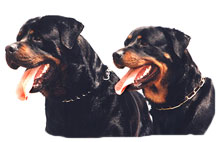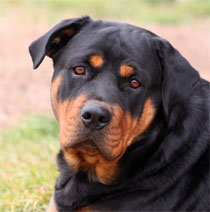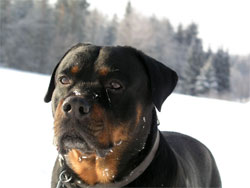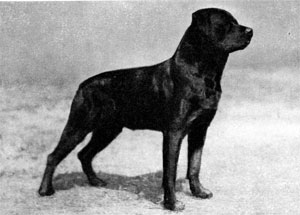|

Runway models: The breed is black with clearly defined tan markings on the
cheeks , muzzle, chest, legs, and eyebrows. The markings on the chest should form two distinct upside-down triangles; a tiny patch of white in between is not acceptable for show dogs. The cheeks should have clearly defined spots that should be separate from the muzzle tan. The muzzle tan should continue over the throat. Each eyebrow should have a spot. Markings on the legs should not be above a third of the leg. On each toe should be a black 'pencil' mark. Underneath the tail should also be tan. Nails are black. Inside the mouth, the cheeks may have black patches, although the tongue is pink. The skull is typically massive, but without excessive jowls. The forehead is wrinkly when the Rottweiler is alert. , muzzle, chest, legs, and eyebrows. The markings on the chest should form two distinct upside-down triangles; a tiny patch of white in between is not acceptable for show dogs. The cheeks should have clearly defined spots that should be separate from the muzzle tan. The muzzle tan should continue over the throat. Each eyebrow should have a spot. Markings on the legs should not be above a third of the leg. On each toe should be a black 'pencil' mark. Underneath the tail should also be tan. Nails are black. Inside the mouth, the cheeks may have black patches, although the tongue is pink. The skull is typically massive, but without excessive jowls. The forehead is wrinkly when the Rottweiler is alert.
 Lovely Eyes: A Rottweiler's eyes are a warm, dark brown—any other color may not be acceptable as part of the "pure breed". The expression should be calm, intelligent, alert, and fearless. The ears are small drop ears that lie flat to the head. 'Flying' ears are considered undesirable by some breeders. The coat is medium length and consists of a waterproof undercoat and a coarse top coat. It is low maintenance, although experiences shedding during certain periods of the year. Lovely Eyes: A Rottweiler's eyes are a warm, dark brown—any other color may not be acceptable as part of the "pure breed". The expression should be calm, intelligent, alert, and fearless. The ears are small drop ears that lie flat to the head. 'Flying' ears are considered undesirable by some breeders. The coat is medium length and consists of a waterproof undercoat and a coarse top coat. It is low maintenance, although experiences shedding during certain periods of the year.
The tail end: Naturally, Rottweilers are a tailed dog. Tails were originally removed to prevent breakage and infection that would occur when the tail became covered in mud and other debris collected from pastures and livestock. Today, many owners in U.S. decide to have the tails removed soon after the puppy's birth for purely cosmetic reasons. The tail is usually docked to the first joint. In the past, this was a commonly accepted practice, however recently many people, organizations and states of the USA have recognized it is cruel and unnecessary - e.g. it has been banned in the European Union.
Barrel Chested: The chest is deep and should reach the Rottie's elbows, giving tremendous lung capacity. The back should be straight; never sloping. According to FCI standard, the Rottweiler stands 24-27 inches at the withers for males, and 22-25 inches for females. Average weight is 110 lbs for males and 95 lbs for females.

 An Undeserved Reputation: A well-trained and socialized Rottweiler can provide the right owner with a great deal of exercise and loving companionship. They are usually quick to learn and have a strong desire to please their owners. They are intelligent, to the point that they shouldn't be left to their own devices, and are happiest when mentally stimulated. Despite this, they can also be strong willed at times, and should be taught in a firm, consistent manner. This is generally a calm breed. That said, they are playful animals, usually very excited at the first sign of fun. Rottweilers thrive on attention from their owners and need their people to be happy. If a Rottie has been neglected excessively, it will usually strive, creatively, to get the owner's attention. An Undeserved Reputation: A well-trained and socialized Rottweiler can provide the right owner with a great deal of exercise and loving companionship. They are usually quick to learn and have a strong desire to please their owners. They are intelligent, to the point that they shouldn't be left to their own devices, and are happiest when mentally stimulated. Despite this, they can also be strong willed at times, and should be taught in a firm, consistent manner. This is generally a calm breed. That said, they are playful animals, usually very excited at the first sign of fun. Rottweilers thrive on attention from their owners and need their people to be happy. If a Rottie has been neglected excessively, it will usually strive, creatively, to get the owner's attention.
Calm before the storm: The Rottie is not usually a barker: males are silent watchers who notice everything and are often quite stoic. Females, however, may become problem barkers in order to protect their den. In the event a dog feels threatened, they tend to go very still before attacking, and there is no warning growl. This is one of the breed's characteristics that lends itself to the reputation of being unreliable. An observant owner, however, is usually able to recognize when the Rottie perceives a threat. When the dog barks, it is more of a sign of annoyance with external factors (car alarms or other disturbances) rather than threats.
A Few Bad Habits: The Rottweiler is typically a dominant dog, and they can resort to aggressiveness in unfamiliar situations. The Rottie's large size and incredible strength make this an important point to consider, and for this reason the Rottweiler is a breed that only experienced dog owners should consider. Rottweiler owners who don't understand the breed's nature can face significant problems in handling such dogs when they reach adulthood. Early socialization with as many people, animals, and situations as possible is very important in order to produce a dog that is tolerant of strangers.
 Bad Press: In recent years, the breed has received some negative publicity, primarily due to a lack of understanding of the breed and canine nature on the part of the owner, and indiscriminate breeding on the part of the breeder. Unscrupulous breeders have produced dogs with highly aggressive tendencies and some owners have used the dogs to boost their macho images. Other owners may acquire a Rottweiler for a family pet, but neglect to properly socialize and train the animal, resulting in a dangerous, unpredictable dog who makes the rules. Bad Press: In recent years, the breed has received some negative publicity, primarily due to a lack of understanding of the breed and canine nature on the part of the owner, and indiscriminate breeding on the part of the breeder. Unscrupulous breeders have produced dogs with highly aggressive tendencies and some owners have used the dogs to boost their macho images. Other owners may acquire a Rottweiler for a family pet, but neglect to properly socialize and train the animal, resulting in a dangerous, unpredictable dog who makes the rules.
The portrayal of Rottweilers as evil dogs in several fictional films and TV series, most notably in The Omen, has contributed to this negative publicity.
Despite the media's fascination with Rottweilers who run afoul of canine behavioral standards, people who have experience with properly raised individuals can attest to the Rottweiler's friendliness and often clownish nature. In fact, the FCI standard calls for a dog that is fond of children. Nevertheless, this breed is not for the inexperienced or uninvolved dog owner, or anyone who lacks the physical strength to handle the Rottweiler.
As a result of bad press, some German Länder put the Rottweiler on an index of so called "dangerous dogs". This includes Bavaria, Brandenburg and North Rhine-Westphalia. Visitors and residents must obey the local muzzling and leash-length laws.

Legionaries: The breed is an ancient one, and its history stretches back to the Roman Empire. In those times, the legions traveled with their meat on the hoof and required the assistance of working dogs to herd the cattle. One route the army traveled was through Württemberg and on to the small market town of Rottweil.

This region eventually became an important cattle area, and the descendants of the Roman cattle dogs proved their worth in both droving and protecting the cattle from robbers and wild animals. It would be a brave villain who would try to remove the purse around the neck of a Rottweiler Metzgershund (Butcher's Dog of Rottweil).
A Population Explosion: However, by the end of the 19th Century, the breed had declined so much that in 1900 there was only one female to be found in the town of Rottweil. But the build up to the World War I saw a great demand for "police dogs," and that led to a revival in interest for the Rottweiler. Its enormous strength, its intelligence, and its ability to take orders made it a natural weapon of war.
From that time, it has become popular with dog owners, and in 1935 the breed was officially recognized by the American Kennel Club. In 1936, Rottweilers were exhibited in Britain at Crufts. In 1966, a separate register was opened for the breed.
All text is available under the terms
of the GNU Free Documentation License
|
